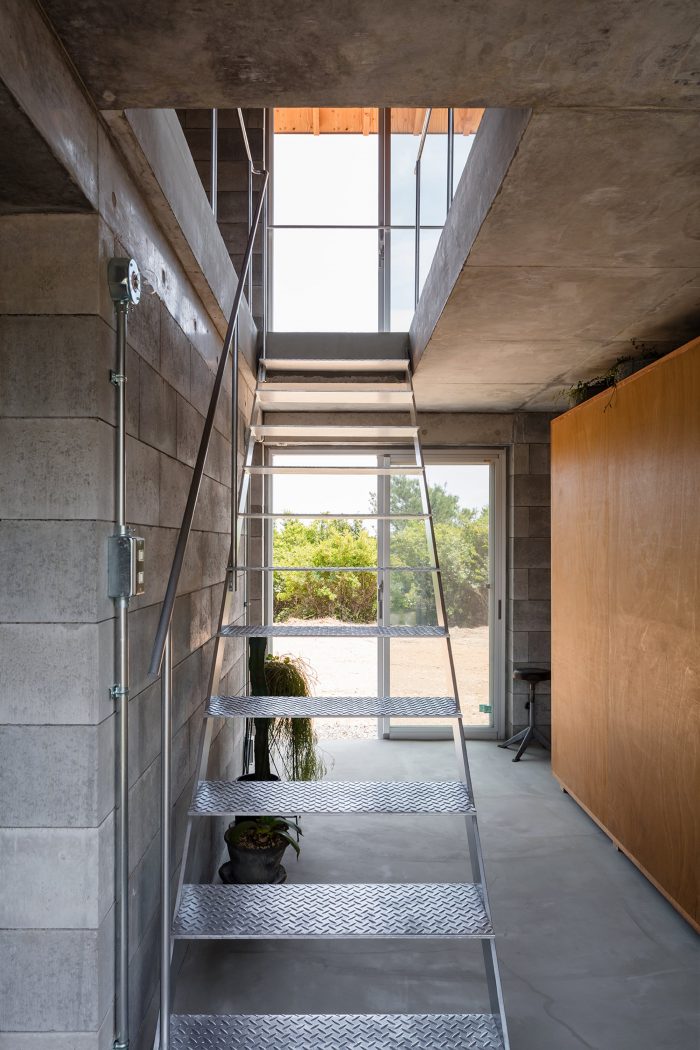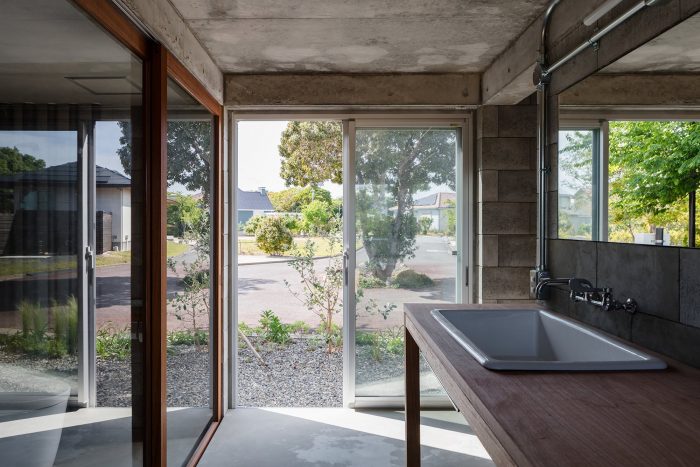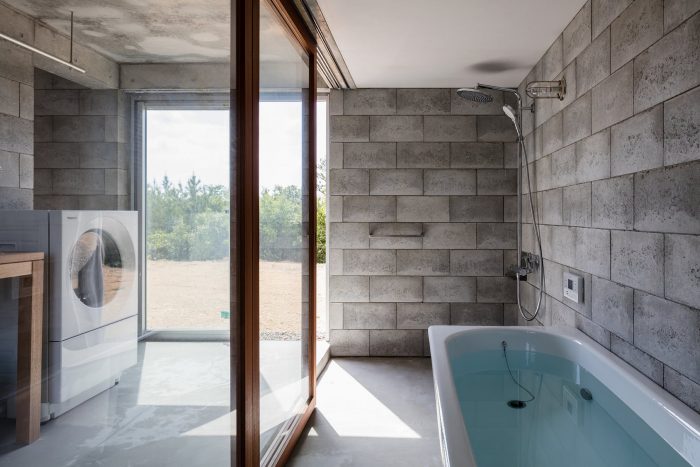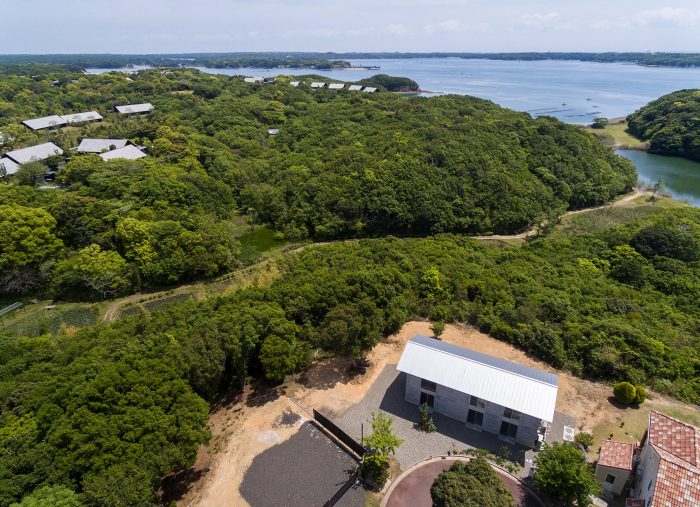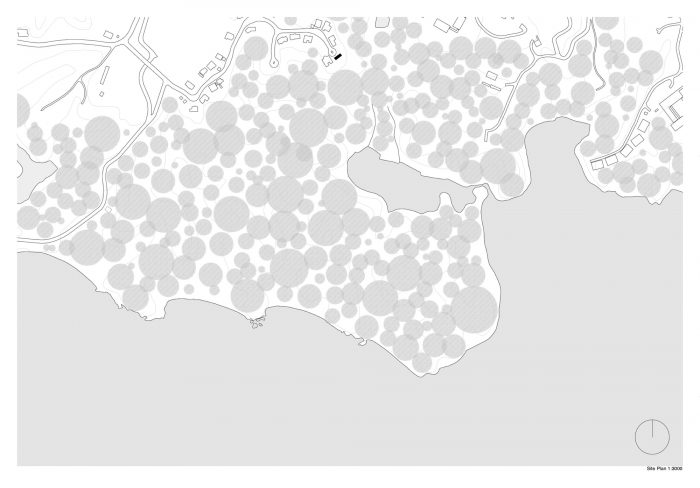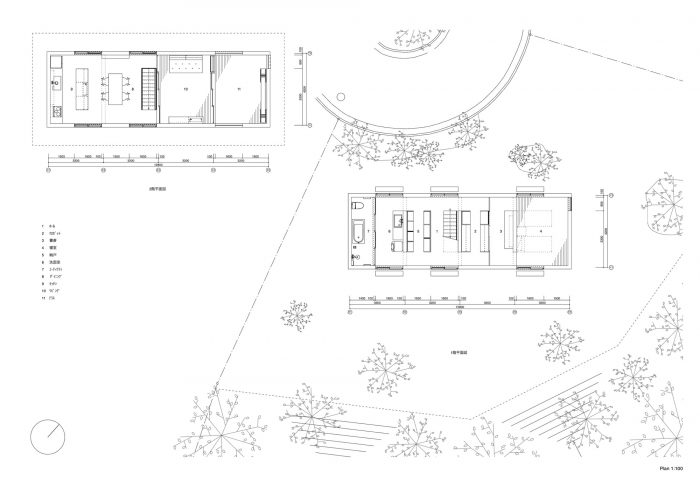这是一个建在伊势志摩国家公园内的紧凑型周末别墅。周围不规则地点缀着私人别墅、企业度假村,以及沿着蜿蜒的道路为永久居民提供的标准住房。对于想在一个充满自然风光的地方度过悠闲时光的主人来说,这不失为一个好地方。在这个没有统一感的城镇景观中,我感到一种不协调的感觉,突然出现在国家公园的荒野中。场地的东南面是一个海拔约30米的悬崖,悬崖的底部如实地伸向大海。
It is a compact weekend house built in Ise-Shima National Park. The surrounding area is dotted irregularly with private villas, corporate resorts, and standard housing for permanent residents along the winding road. It’s not a bad place for the owner who wants to spend a relaxing time in a place full of nature with a view of the sea, I felt a sense of incongruity in this townscape without a sense of unity that suddenly appeared in the wilderness of the national park. The southeast side of the site is a cliff about 30m above sea level, and the bottom of the cliff reaches the sea as it is.
一个两层的钢筋混凝土砌块结构是面向大海的。悬崖和建筑之间的距离是由《悬崖条例》决定的。一楼的每个空间都是松散的隔断,有最小必要的承重墙和可移动的家具和配件。梁下最低点的天花板高度为1880mm。考虑到居民的身高,尺度尽量保持较低。
A two-story reinforced concrete block structure is placed facing the sea. The distance between the cliff and the building was determined by the Cliff Ordinance. Each space on the first floor is loosely partitioned with the minimum necessary load-bearing walls and movable furniture and fittings. The ceiling height is 1880mm at the lowest point under the beam. Considering the height of the residents, the scale is kept as low as possible.
相比之下,二楼是一个宽敞的空间,只有LDK和一个露台,并悬挂了一个木制屋顶结构。特别是,客厅和露台的地板、墙壁和天花板都采用了相同的材料,在内部和外部之间形成了一个模糊的界限。
In contrast, the second floor is a spacious space with only LDK and a terrace, and a wooden roof structure is hung. In particular, the living room and terrace are all made of the same material for the floor, walls, and ceiling, creating a vague boundary between inside and outside.
起初,我们考虑无视这种城镇景观,创造一个符合业主个性的定制设计。然而,最后,我们采用了房屋、长方形和两层楼房的普遍模式。使用给人一种似曾相识的感觉的混凝土块,并根据200×400的标准尺寸限制了设计的自由度。
At first, we considered ignoring this townscape and creating a custom-made design that matched the personality of the owner. However, in the end, we adopted the universal model of a house, rectangle, and two-story building. Using concrete blocks that give a sense of déjà vu, and limiting the degree of freedom in design according to the standard dimensions of 200 x 400,
这个地方似乎很自然地有一个元素,在某种程度上导致了大规模生产的标准住房。在设计中,我们关注的是内部和外部,普遍性和专业性,开放性和紧密性,等等。建筑学不可避免地产生的矛盾元素应该相互协调,共存共荣。这样做,建筑的轮廓和边界就会变得模糊,我们设计师的个人随意性也会被淡化。我想,这将是一个允许居民和游客的各种看法,以及各种周围环境的东西。希望这种灵活和宽容的建筑能够随着时间的推移融合自然和城镇景观之间的界限。
It seemed natural for this site to have an element that somehow leads to mass-produced standard housing. In designing, we focused on interior and exterior, universality and specialty, openness and closeness, etc. The contradictory elements that architecture inevitably creates should be in harmony with each other and coexist. By doing so, the contours and boundaries of the building are blurred, and the personal arbitrariness of us designers is diluted. I thought that it would be something that allows for various perceptions of residents and visitors, as well as all kinds of surrounding environments. Hopefully, this flexible and tolerant architecture will blend the boundary between nature and the townscape over time.
Architects: KKAA YTAA
Area : 94 m²
Year : 2020
Photographs :Norihito Yamauchi
Manufacturers : Daiwa Heavy Industry, KYOEI LUMBER, TAIYO ECOBLOXX
Contractors : SOOTO
Structural Design : Ukyo Architectural Construction Office
Design Team : Kei Kitano, Takanobu Yagi
City : Shima
Country : Japan









